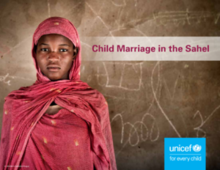This brochure from UNICEF provides an overview of child marriage in the Sahel, a region spanning the northern portion of sub-Saharan Africa. The purpose of this publication is to offer a descriptive analysis of the practice of child marriage in the Sahel, covering: the proportion and number of girls and women affected; disparities in risk across different populations; a selection of key outcome measures for women who married in childhood; an evaluation of historical trends in prevalence; and projections through 2030. It relies on nationally representative survey data, namely from the Demographic and Health Surveys (DHS) and Multiple Indicator Cluster Surveys (MICS), which provide comparable data on the practice over time, along with data on respondents’ background characteristics and key measures of well-being that facilitate this analysis. Additional research questions, including on families’ decision-making about marriage, the impact of programmes and drivers of change fall outside the scope of this analysis.
To assess the prevalence of child marriage, this analysis used SDG indicator 5.3.1 – the proportion of women aged 20 to 24 years who were first married or in union before age 18. The number of child brides is defined as the number of girls under 18 who have already married plus the number of adult women who were married before age 18. This is calculated using the estimated prevalence of child marriage among each age cohort, applied to the female population in the respective cohort. This method relies on both household survey data for prevalence and demographic data for the size of the population (See section on ‘Data sources’).
According to the brochure 20 million child brides (under 18) live in the Sahel today. As a consequence, 95% of married adolescent girls do not attend school and most do not have a say in major decisions in their households. More generally, this harmful practice has a devastating consequence for these young women’s identity, as it is unduly modified.

